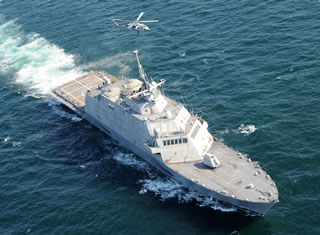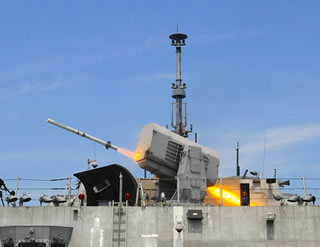
The Lockheed Martin built Freedom class Littoral Combat Ship (LCS-1) is already in service, and could be deployed for its first mission as early as next year (early 2010) – two years ahead of its scheduled maiden deployment. The second vessel, USS Independence has completed builders sea trials last week and is awaiting inspection by the customer, prior to handover to the U.S. Navy. According to Navy plans, USS Freedom which is currently undergoing a ‘shakedown’ by the navy, will be ready for operational deployment by early 2010, operating under the U.S. Navy Southern Command and Pacific Command.

According to Adm. Gary Roughead, chief of naval operations, the early deployment of the LCS will improve the U.S. Navy’s ability to dominate littoral regions. Absence of such assets has opened a warfighting gaps that must be urgently closed. Offering unique combat capabilities not previously addressed by the ‘Blue Sea’ cruisers and destroyers, the LCS could have a dramatic impact on the readiness and global reach of the U.S. Navy. To facilitate the early deployment, the Navy adjusted the Freedom testing schedule; prioritized testing events needed for deployment and deferred others not required for the missions envisioned during this deployment.
Accelerated Fielding of Mission Systems

The Littoral Combat Ship (LCS) is designed for operations near coastlines and in the littoral areas, tasked with anti-submarine warfare (ASW), surface warfare (SUW) and mine warfare (MIW) missions. LCS leverage its modularity from the Mission Package (MP) concept – a mission focused group of mission systems and specialist personnel providing the ship its warfighting capability. The MP is embarked on an LCS prior to a mission, enhancing its capability to assume specific tasks or operate against the identified threat. After a mission is completed, the MP is disembarked and restored for future use in any LCS. The MP comprises individual elements, called Mission Systems, and support equipment, together form a Mission Module (MM). One or more MMs along with the crew and support aircraft form an MP.
To facilitate early fielding the planned testing schedule of the ship will be altered, focusing on the testing of vessel’s shakedown, overseas sustainment, crew training and combat systems and mission packages related to the anticipated mission scope of the vessel. As part of these tests, the Navy performed structural test firing with the vessel’s Mk110 57mm gun and the Surface Warfare (SUW) 30mm Gun Mission Module, while the ship was at sea off the Virginia coast. Different mission modules comprise the LCS mission packages, which are a combined set of remote sensors, precision weapons, software components and off-board vehicles packaged in a modular fashion to easily and quickly swap in and out of the LCS. Each mission package provides warfighting capabilities for a focused mission area.

The SUW Mission Package is specifically designed to defeat fast in-shore attack craft. Another element of the SUW Mission Package is the NLOS-LS medium range surface to surface missile module. This module will begin at-sea testing in 2012.
“As the Navy moves towards multipurpose ships with modular design, it only makes sense that our maintenance and support activities adapt,” sais Program Executive Officer, Littoral and Mine Warfare, E. Anne Sandel, endorsing the newly established Mission Package Support Facility (MPSF). “This is a great first step in the advancement of Navy surface combatant lifecycle support philosophies.” Sandel added. The Navy has recently established the LCS (MPSF) located near USS Freedom’s San Diego, California home port. Providing the central hub supporting the vessel’s mission packages, the new facility will store, deploy, upgrade and maintain the systems and elements that comprise the Mission Packages (MP), address afloat maintenance issues and provide technical support for Mission Module detachments. While the LCS is at sea, MPSF will have a virtual presence on deck, using Distance Support, to assist the crew operating, supporting and reconfigure all deployed Mission Modules.



















